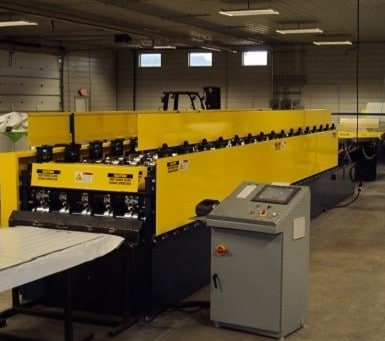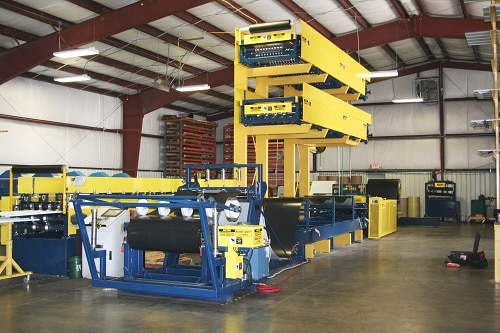Metal Rollforming Systems offers three series of panel lines: the Titan, Signature, and Patriot. The Titan and Signature can be bought as either a single profile or dual profile line.
All single profile MRS machines can be modified in the field, as needed, to add a second profile after the purchase.
The number after the series name indicates the number of profiles: the Titan I and Signature I are both single profile; the Titan II and Signature II are both double profile.
Bill Griffin, an owner and partner at MRS, said adding a second deck for a dual-height machine is around 50% of the initial machine cost, making it more cost-affective than the purchase of two separate machines.
The Patriot is a multiple profile machine and is available with one or multiple “rafts” or “cartridges,” which can be switched out by the operator as needed. The cartridges “can be swapped onto the subframe in a matter of minutes,” Griffin noted.
It does take longer to change over than the double deck lines, because the tooling on double decks is installed at all times and the infeed raised or lowered to feed the correct profile. “It takes 10 to 20 minutes to change a raft, and only 30 seconds to change between profiles on a Signature II or Titan II,” Griffin explained.
Just over half of the startup customers at MRS opt for a single profile machine, Griffin noted. “It keeps startup costs down and gives them the flexibility to feel out their market for the right second profile. As new profile designee merge and become more popular, the amount of people going with double decks continue to increase,” he said.
When talking to potential buyers, Griffin said, “I always begin the conversation with what profile or profiles are you interested in, and what are your anticipated volumes? You’re going to want at minimum $250,000 in yearly sales for the second profile to justify the equipment and inventory costs. If you are utilizing your same inventory for both products, that number can drop to $100,000 in yearly sales.
“If you decide to start with a single deck line, it is still very important to discuss with your sales engineer what profile you may want to add later,” he continued. “In some cases, the frame may require lengthening or widening. It is much easier to do this during the initial manufacturing process than to try and do it afterward.”
Knowing at what point to add a second profile can be tricky. Perhaps you don’t have the demand now, but by having it available you may be opening the door to more opportunity. Bottom line, it comes down to your market and your potential return on investment (ROI).
“By adding another profile, you will exponentially increase your demand for it because you now are able to turn it around quicker than if you were to wholesale it,” Griffin said. “I would approach this as: What will it cost me to add inventory and equipment based on what my return will be? In most cases, the ROI should be in the two to five year range.
“The buyer also needs to take into consideration that by having additional product offerings, they can appeal to and service a larger market base—typically this would increase sales of their existing product lines as well, sometimes in the 10% to 30% range.”
An important consideration in purchasing a dual level/double profile machine is the increasing variety of panels being offered and a thirst for variety by consumers. Styles that can utilize existing coil inventory are an obvious plus. “We’re seeing a big movement toward panels designed to mimic the snap lock look,” Griffin said. “It seems to be a more aesthetically-pleasing choice to homeowners, but the installed costs for a true snap lock are significantly more than a through-fastened panel. Because of this we have pioneered new profiles that mimic the narrow rib, wide pan look but stack, ship, and install just like an ag panel. In most cases you can even use your existing coil inventory and trim profiles.” RF



Recent Comments